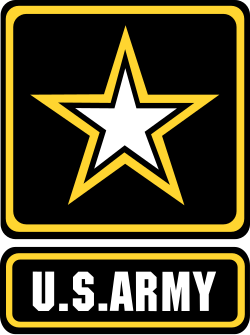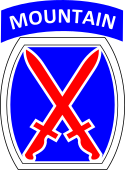3rd Cavalry Regiment

Das 3rd Cavalry Regiment (deutsch 3. Kavallerieregiment) ist ein Regiment der United States Army mit Hauptquartier in Fort Cavazos, Texas. Der Traditionsname des Regiments ist Brave Rifles (rifles bezeichnet sowohl Gewehre mit gezogenem Lauf als auch die damit bewaffneten Schützen). Das Regiment wurde am 19. Mai 1846 als Regiment of Mounted Riflemen (Jäger zu Pferde) in Missouri gegründet und wurde zu Beginn des Sezessionskrieges zum 3rd Cavalry Regiment. Es kämpfte danach unter anderem auch in den Indianerkriegen, im Mexikanisch-Amerikanischen Krieg, im Spanisch-Amerikanischen Krieg, im Philippinisch-Amerikanischen Krieg, im Ersten und Zweiten Weltkrieg, im Zweiten Golfkrieg sowie im Irakkrieg. Nachdem es aufgrund seiner zeitweiligen Ausstattung mit schweren Kampfpanzern als 3rd Armored Cavalry Regiment bezeichnet wurde, führt es seit 2011 wieder den Namen 3rd Cavalry Regiment.
Gliederung und Ausrüstung
1942 wurde das bis dahin noch berittene Regiment zum Panzeraufklärungsverband umgerüstet. Nach dem Zweiten Weltkrieg erhielt es Kampfpanzer, bis es 2011 mit Stryker-Radpanzern ausgestattet wurde.
Im Unterschied zu der sonst in der US-Army üblichen Form der Bezeichnung von Truppenteilen unterhalb der Regimentsebene (Zug/Platoon, Kompanie/Company, Bataillon/Battalion) lauten die Bezeichnungen in der US-Kavallerie Platoon, Troop und Squadron (Eskadron).[1]
Letzte Gliederung als Verband der Panzertruppe
Regimental Headquarters and Headquarters Troop "Remington"
Die Regimental Headquarters and Headquarters Troop "Remington" ist das Regimentshauptquartier, die Stabs- und Verwaltungseinheit des Regiments. Die Ausrüstung besteht aus:
- 2 M2A3 Bradleys in der Ausführung als Command Track (mobile Befehlsstelle mit Kettenantrieb),
- 11–15 M577 Führungs – und Befehlsfahrzeugen,
- diversen Transport – und Logistikfahrzeugen zur Regimentsversorgung.
1st, 2nd und 3rd Cavalry Squadron
Den Kampftruppenkern des Regiments stellten diese drei Squadrons dar. Ihre Aufstellung war einheitlich. Sie wurden jeweils von einem Lieutenant Colonel kommandiert. Insgesamt verfügte eine Squadron über 53 Offiziere, 339 Unteroffiziere und 499 Mannschaften, insgesamt 891 Mann.
Jede Squadron war folgendermaßen gegliedert:
- Headquarters Troop: Zwei Bradley M3A2 Kommandopanzerwagen, sechs M577 Kommandofahrzeuge, diverse Berge- und Transportfahrzeuge.
- Drei Armored Cavalry Troops: Jede Troop verfügte über eine HQ-Abteilung mit einem M1A2 Abrams, einem M2A3 Bradley und einem M577 Kommandofahrzeug, über zwei Aufklärungszüge mit je sechs M2A3 Bradley, über zwei Panzerzüge mit je vier M1A2 Abrams und eine Mörsergruppe mit zwei M1064 Mörserträgern sowie 12 Ketten- oder Radfahrzeugen zur Versorgung.
- Eine Panzerkompanie: Sie bestand aus 14 M1A2 Abrams und stand dem Befehlshaber der Squadron als mobile Reserve zur Verfügung.
- Artilleriebatterie: mit acht Panzerhaubitzen M109 und acht Munitionstransportern.
4th Air Cavalry Squadron
Hierbei handelte es sich um das luftbewegliche Element des Regiments unter dem Kommando eines Lieutenant Colonel der Heeresflieger.
Gliederung der Squadron: Headquarters and Headquarters Troop ("Headhunters")
- N Troop ("Nomad") mit AH-64D Apache Longbow Kampfhubschraubern.
- O Troop ("Outlaw") mit AH-64D Apache Longbow.
- P Troop ("Pegasus") mit AH-64D Apache Longbow.
- Q Troop ("Quicksilver") mit Drohnen des Typs AAI RQ-7 Shadow.
- R Troop ("Renegade"), Forward Support Troop (FST).
- S Troop ("Stetson") mit UH-60L Blackhawk Mehrzweckhubschraubern.
- T Troop ("Tomahawk"), Instandsetzungseinheit.
- AVIM Troop ("Air Raiders") – Aviation Intermediate Maintenance.
Support Squadron ("Muleskinner")
Diese Squadron versorgte das Regiment und verfügte über:
- Headquarters and Headquarters Troop ("Bullwhip"), Stabskompanie.
- Supply and Transportation Troop ("Packhorse"), Nachschub- und Transportkompanie.
- Maintenance Troop ("Blacksmith"), Wartungseinheit.
- Medical Troop ("Scalpel"), medizinische Versorgung.
Ferner wurde das Regiment durch die 43rd Combat Engineer Company (Panzer-Pionier-Kompanie) unterstützt, die 66th Military Intelligence Company (militärischer Nachrichtendienst), die 89th Chemical Company "Chemdawg" (ABC-Abwehrkompanie) und eine Luftabwehrabteilung.
Gliederung als Verband der mechanisierten Infanterie ab 2011
Die ersten drei Squadron wurden mit Stryker-Schützenpanzern ausgestattet, die vierte mit Stryker-Aufklärungspanzern.
Anmerkungen
- ↑ Vgl. dazu Clancy, Tom, Armored Cavalry. Die verbundenen amerikanischen Panzereinheiten, München 1997, S. 268.
Literatur
- Tom Clancy: Armored Cavalry. Wilhelm Heyne Verlag, München 2000, ISBN 3-453-15541-6, S. 263 f
Weblinks
Auf dieser Seite verwendete Medien
4th Infantry Division shoulder insignia :
I created this work during the course of my official duties. As a United States Army soldier, it is considered the work of the United States Federal Government, and as such is in the public domain. -- Steven Williamson (HiB2Bornot2B) - talk 15:49, 26 July 2007 (UTC)
Autor/Urheber: Diese W3C-unbestimmte Vektorgrafik wurde mit Inkscape erstellt ., Lizenz: CC BY-SA 3.0
The shoulder sleeve insignia of 2d Stryker Cavalry Regiment
The official logo of the United States Army (USA). It can be seen on the official United States Army website in September 2001.
US 1st Cavalry Division
SHOULDER SLEEVE INSIGNIA
- Description: On a yellow triangular Norman shield with rounded corners 5 1/4 inches in height overall, a black diagonal stripe extending over the shield from upper left to lower right and in the upper right a black horse's head cut off diagonally at the neck all within a 1/8 inch green border.
- Symbolism: Yellow, the traditional cavalry color, and the horse's head refer to the division's original cavalry structure. Black, symbolic of iron, alludes to the transition to tanks and armor. The black diagonal stripe represents a sword baldric and is a mark of military honor; it also implies movement "up the field" and thus symbolizes aggressive elan and attack. The one diagonal bend, as well as the one horse's head, also alludes to the division's numerical designation.
- Background: The shoulder sleeve insignia was originally approved January 3, 1921 with several variations in colors of the bend and horse's head to reflect the subordinate elements of the division. The current design was authorized for wear by all subordinate elements of the division on December 11, 1934 and previous authorization for the variations was cancelled.
3rd Infantry Division Shoulder Sleeve Insignia
1st Infantry Division Combat Service Identification Badge
75th Ranger Regiment Distinctive Unit Insignia
25th Infantry Division Shoulder Sleeve Insignia
The 11th Armored Cavalry Regiment Shoulder Patch
The official insignia for the 11th Airborne Division. The Army will re-designate U.S. Army Alaska and two Alaska-based brigade combat teams this summer as the 11th Airborne Division Headquarters and the 1st and 2nd Brigade Combat Teams, 11th Airborne Division. This re-designation is an outgrowth of the Army’s January 2021 Arctic Strategy and sets us on the path towards a force that is more appropriately manned, trained, and equipped for the Arctic environment.
Shoulder Sleeve Insignia of the United States Army Special Operations Command.
Description: On a red stylized spearhead with a 1/8 inch red border, 3 1/2 inches in height and 2 inches in width overall, a black Fairbairn-Sykes dagger. A black tab with "AIRBORNE" in red letters is attached above the insignia.
Symbolism: The stylized spearhead alludes to the shoulder sleeve insignia worn by the lst Special Service Forces and signifies the heritage and traditions that the US Army Special Operations Command will perpetuate. The unsheathed black dagger symbolizes total military preparedness and has long been associated with Army special operation forces. The airborne tab designates the command's airborne status.
Background: The shoulder sleeve insignia was approved effective 1 December 1989.Shoulder Patch of 173rd Airborne Brigade
3rd Armored Regiment Shoulder Sleeve Insignia
1st Special Forces Operational Detachment Delta Unit Patch
US Army 1st Armored Division Shoulder Sleeve Insignia
- Upon a five pointed white star whose points lie in the circumference of an imaginary circle 3-1/2 inches (8.89 cm) in diameter a Native American's head with war bonnet in profile, face red, bonnet blue with outline of feathers in blue.
- The star to be superimposed upon a black shield, of dimensions such that the points of the star shall lie at a distance of 1/8 inch (.32 cm) from the perimeter.
Symbolism:
- The star has played an important part in our history from the days of the Colonies to the present time.
- The Native signifies the first and original American.
- These devices were originally established by the division to use as vehicle markings and to identify the vehicles as all American.
Background:
- The shoulder sleeve insignia was originally authorized for the 2d Division on 6 Nov 1918, officially announced by The Adjutant General letter, 21 Jun 1922, amended to correct the description on 7 Nov 1927 and redesignated for the 2d Infantry Division on 1 Aug 1942.
Work of Federal Government
Shoulder sleeve patch of the U.S. 10th Mountain Division The 10th Mountain shoulder patch consists of a white-bordered powder keg. The powder keg is in blue and, superimposed on it are two red bayonets in saltire so as to form the Roman numeral “X”. The bayonets represent the Infantry and the numerical designation of the Division. This is the Shoulder Sleeve Insignia; the Distinctive Unit Insignia can be found at Image:10th Mountain Division-distinctive unit insignia.jpeg.
On a blue powder keg-like background, with a white border, two bayonets in saltire throughout scarlet fimbriated white. The blue background and the bayonets are symbolic of infantry while the position of the bayonets in saltire simulates the numerical designation of the organization.


















